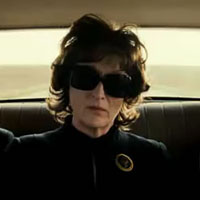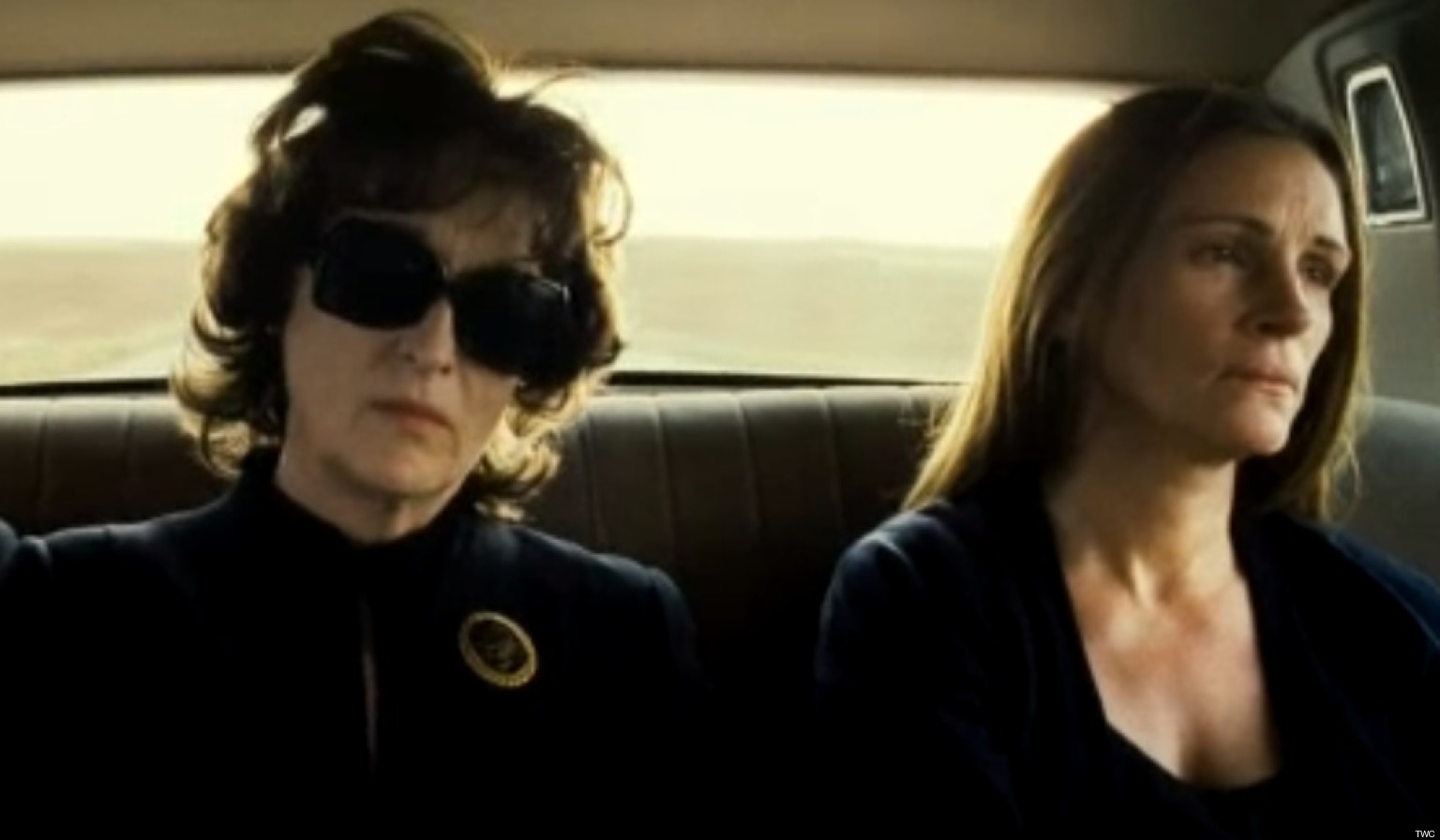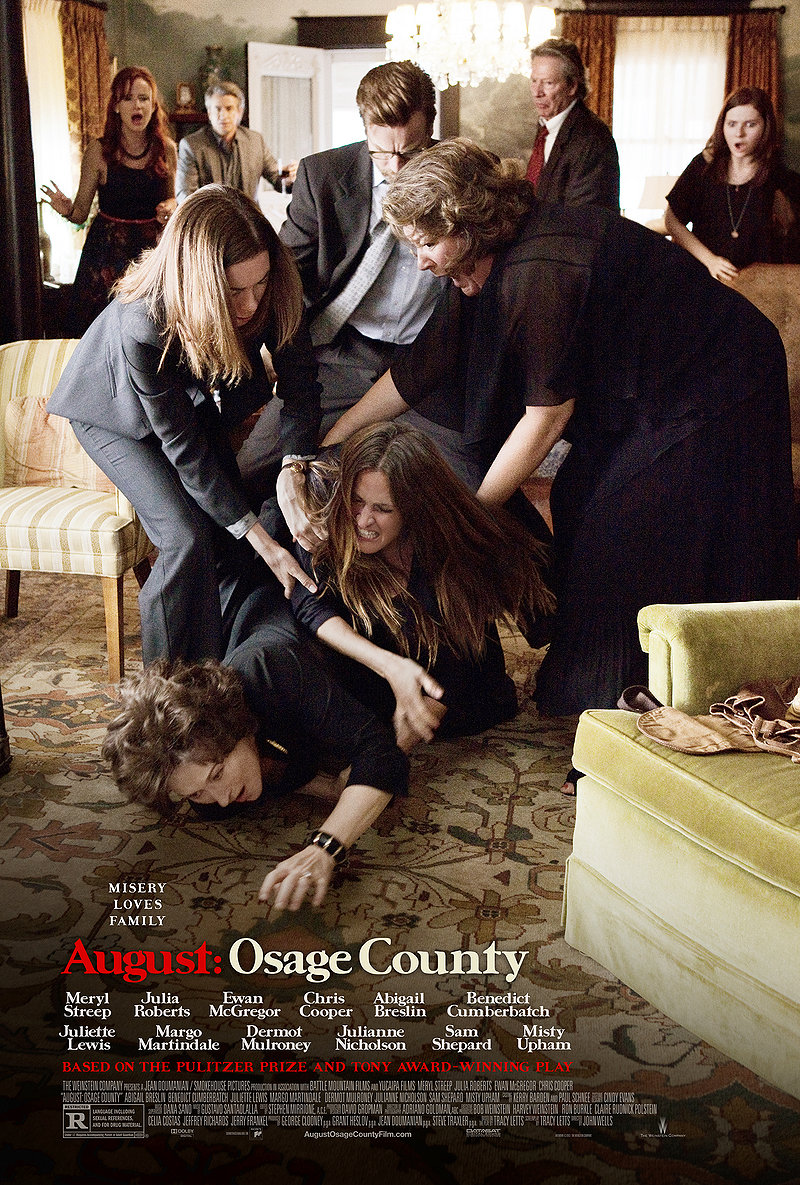
During my time writing for the Arcade I have had occasion to refer to a film critic of some repute, officially the UKs most trusted. Although he shrugs off such accolades, it is not difficult to see why he is held in such high esteem. Even when you find yourself – or rather I find myself – in disagreement with his verdict the chances are good he’ll have something to say that is worth listening to. I am of course referring to Mark Kermode. Kermode bears special mention as last week I saw a film to which I had response that was radically different to his. The film is question? August: Osage County. The Kermode review can be found below and mine follows shortly thereafter; however, before you click the hyperlink below or continue to read the rest of this post I must issue a caution in the next paragraph.
August: Osage County is a comedy, but it is a black comedy. In fact, Tracy Letts’ previous screen adaption Killer Joe was termed a jet black comedy (by Kermode no less). You will not like this film if you don’t have the palette for this type of humour. I use the word palette because to use the word stomach or stones sounds like a challenge. Frankly I don’t wish for anyone to undergo an experience they won’t enjoy because they feel they’ve got something to prove: after all “it’s only a movie”. If you don’t want to watch a film that will cause you to intermittently turn away in an awkward mix of embrace and amusement then it is (more than) likely that this is not a film for you and, furthermore, you might want to stop reading now. By the same token, if this sounds like a something you are intrigued by I’d advise stop at this paragraph and return once you have trotted down to the local multiplex or picture house.
So, the story opens with an older couple that are both heavily (self) medicated hiring a young women to act as their nurse and maid. She is to assist them while the wife of the couple Violet Weston (Meryl Streep) is undergoing treatment for oral cancer. The interview is being conducted by her husband Beverly (Sam Shepherd). Eventually Vi emerged and the couple engage in a brief foray of wits, cutting and sardonic. While the action for the most part takes place in Oklahoma, this is not the Oklahoma “where the wind comes sweeping down the plain And the waving wheat can sure smell sweet”. The action picks up a few weeks later when Beverly has not been seen for many days and the family converge on the family converge on the homestead to console the matriarch. From there the taunts and jibes proceed to pepper the screen, more people meaning more ammunition snipers and correspondingly more targets.
Preliminary points made and synopsis submitted I can now address the heart of my disagreement with Dr Kermode and the film itself. Kermode’s view in the tersest of terms was that the film is while not without interest but that “as a piece it just sits there […] terribly inert”. It is certainly true that the film’s pace and movement is that of pile in set piece dialogue atop set piece dialogue. Yet while Kermode found this to be a flaw, I did not. In fact I found it to be entirely of apiece with the characterisation and plot. The film operates by a process of revelations. These revelations are imbued with an irony that they are only revelatory in superficial terms, that is to say they reveal some awkward fact or inconvenient truth of the family that was hitherto unknown. Yet said fact or truth only confirms a larger truth of which the characters all painfully aware and we soon come to realise: the place and people are poisonous. The central conceit, in other words, is that despite a sequence of still more unnerving revelation nothing changes.
 Whereas Mark Kermode found that “allowing the action to proceed from one theatrical setpiece to the next” imbued the film itself with a sense of inertia, I found that the film’s movements frustrated any hopes for reconciliation within the family, fully capturing the interfamilial inertia. It is a fitting comparison: while the revelations of the film are stagnant the revelations of Dr Kermode are, as ever, fruitful.
Whereas Mark Kermode found that “allowing the action to proceed from one theatrical setpiece to the next” imbued the film itself with a sense of inertia, I found that the film’s movements frustrated any hopes for reconciliation within the family, fully capturing the interfamilial inertia. It is a fitting comparison: while the revelations of the film are stagnant the revelations of Dr Kermode are, as ever, fruitful.
Before we get to talking about the use of photography and location or the leading performances of Streep and Roberts there are two presumptions that the film shatters that warrant a moment’s note.
At this time it has be universally disregarded that men cannot write women characters (eg. Woody Allen and DH Lawrence and insert male writer here etcetera). Yet there is a lingering supposition that that men writing about flawed women are sexist as a matter of necessity. When I sat in the Greenwich Picture house as saw the credits role I not only thought Tracy Letts was a woman but thought Letts had been brave to cast a so many female characters in such a problematic light. In the first place this demonstrates my initial ignorance of Letts’ career. So does the second up to a point. Balance of probability rules that somebody named Tracy is most likely female. More than this however is the attention to detail in drawing different gendered characters. Failure to look past the snarling dialogue you might accuse Letts of being insensitive, but nothing could be further from the truth. The film is an explosive testament that men can write about women in a way that while unflattering is not at all misogynistic.
Older actors are worth a damn: that is our second pernicious presumption. A more nuanced expression would be actors have a short shelf life on screen. Even before we could to our leading lady makes her entrance we are enamoured by Sam Shepherd, who is on screen no more than 20 minutes, yet he never fails to own the space or at least co-owns it when Meryl makes her move. Chris Cooper also delivers as a moving performance. Some have described him as the most human characters, though I would amend this to the most humane character. As the only family member not that is not a blood relative he is a stranger in their midst, but strange only in that he the only character not subjected to a compromise, humanising his adoptive family the Westons.
However, the show is utterly stolen by Meryl Streep, whose performance is graced by a combination of talent and good writing. The film is crafted in such a way that its constituent parts fold in on the character of Vi, from the open plains to the house right down to the soft furnishings. While some might buckle and bag under the cumulative weight, Streep does quite the opposite. As I glance over my notes a have to remind myself not to turn a review into a full-blooded analysis, submitting readers to tedious, ex-student scrawl. Yet I shall beg your patience a moment in considering the central performance in relation to its setting. The juxtapositions of Violet’s character are perhaps best realised in the Oklahoma plains, beautiful and ravaged, intriguing and foreboding, constant and mutable. Beautifully shot by Adriano Goldman, the plains form a plangent and near perfect metonymic backdrop.
It has been much noted that the plains are ironic in their being an open space which also function as a prison. Vi will never escape yet there is an ambiguity regarding the fate of her eldest daughter the headstrong and if not fierce then fiercely intelligent Barbra, played by Julia Roberts, who is weary of turning into a mother she both reviles and reveres in equal measure.
I have already mentioned that there is more to be said on this film than can be appropriately dealt with here. Yet that fact that there is much that I must leave unsaid is revealing of how rewarding the film is for those that pay it close attention. Not only that but coming away from it I am convinced that there is much in the film that will remain unrevealed until a second viewing. For that reason I cannot wait to see it again.
[easyreview cat1title=”The Arcade Verdict” cat1detail=”” cat1rating=”8″]












